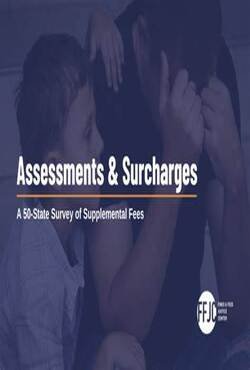By The American Bar Association, Standing Committee on Legal Aid and Indigent Defense and Arnold Ventures
For some people in New Mexico, a $100 fee could be paid the same day with little thought. For most New Mexicans, however, $100 is a significant percentage of monthly income, and payment might require the person to forego groceries or diapers or miss a car or rent payment.1 Despite these differences, in administering court fines and fees, New Mexico courts fail to adequately distinguish between those with the ability to pay and those for whom payment causes grave hardship. Far too often the result is the incarceration of those unable to pay in violation of Bearden v. Georgia. 2 The American Bar Association (ABA) has developed extensive policies to provide guidance to jurisdictions on how to fairly administer court fines and fees to ensure that individuals are not punished simply for being poor. In 2018, the ABA adopted the Ten Guidelines on Court Fines and Fees, which urge jurisdictions to eliminate or strictly limit user fees (Guideline 1), ensure timely and fair assessment of ability to pay (Guideline 4 & 7), waive or reduce fines and fees based on ability to pay (Guidelines 1 & 2), refrain from using driver’s license suspensions or other disproportionate punishments for nonpayment (Guideline 3), allow individualized alternatives to monetary penalties (Guideline 6), and provide counsel for individuals facing incarceration as a consequence of failure to pay (Guideline 8). To understand the administration of fines and fees in New Mexico’s misdemeanor courts, a team from the ABA Standing Committee on Legal Aid and Indigent Defense (ABA SCLAID) conducted court observation of the state’s Metropolitan, Magistrate, and Municipal Courts over a four-year period from 2018 to 2022. These observations revealed that New Mexico courts routinely fall short of ABA standards. Some of the study’s key observations include: • New Mexico courts assess a wide variety of fees, not just upon conviction, but also pretrial, for supervision, and in connection with bench warrants. Many of these are user fees. • New Mexico rules do not provide for timely assessment of ability to pay, nor do they provide adequate opportunities for reductions or waivers based on substantial hardship. • Current “ability to pay” assessments only allow an individual to adjust payment plans usually to make smaller monthly payments for longer periods, which increases opportunities for failure to pay and extends the individual’s involvement with the criminal justice system. • Bench warrants are routinely issued for failure to appear and, in addition to being subject to arrest, the individual is charged a $100 fee, and his/her driver’s license is suspended. • Unpaid fees often result in further bench warrants, with accompanying fees, exacerbating the cycle of bench warrants, arrests, and debt. • When arrested on a bench warrant for failure to pay, individuals are jailed without a finding that the failure to pay was willful.
• Judges rarely reduce or waive fines or fees unless the individual first serves time in jail. • The “payment” of fines and fees through credit for jail time is common. These fines and fees result in little, if any, financial benefit to New Mexico. A case study of individuals who were arraigned in Bernalillo County (Albuquerque) Metropolitan Court (incustody) during a one-week period in 2017 showed that 93% “paid” their fines and fees exclusively through incarceration, while only 3% actually paid their fines and fees in full. A similar one-week study of 2021 cases showed that incarceration remains the dominant form of “payment” (73% of individuals satisfied at least a portion of their fines and fees with jail time), while a similarly small percentage of individuals (4%) paid their fines and fees in full.3 To comply with ABA policies, New Mexico should consider: • Eliminating or reducing court fees, particularly user fees; • Revising procedures to ensure prompt consideration of ability to pay at the time fees or fines are imposed; • Ensuring that those for whom payment would cause substantial hardship have access to waiver or reduction of fees; • Improving the hearing notice process and increasing second-chance opportunities before bench warrants issue for failure to appear; • Discontinuing driver’s license suspension as a consequence of nonpayment; • Ensuring that individuals cannot be jailed for nonpayment until after an ability to pay hearing and a finding that the failure to pay was willful; • Guaranteeing counsel for any indigent individual facing incarceration for failure to pay; and • Improving alternative payment options and ensuring that those options are personalized and account for each individual’s circumstances. By adopting the recommendations of this report, New Mexico courts can bring their practices into compliance with not only with ABA policy, but also with the requirements of the U.S. Constitution. For this reason, New Mexico should consider reforms to improve its fine and fees procedures and ensure that its criminal justice system does not punish individuals simply for being poor.4
Chicago: ABA, 2023. 67p.








